Checking the Cathode Voltage for the 6550A Output Tubes
The first step in servicing the Leslie Amp is to check the Voltages at various points to determine the amp’s operating condition.
There is one place I like to check first that gives you a fast indicator as to whether the Amp is operating correctly. This is the Cathode Resistor for the 6550 output tubes.
If the power supply is working right and the output tubes are conducting correctly, then this voltage will be right. The “top” of the 150 ohm cathode resistor should be 25VDC.
If this voltage is low;
- Some power supply voltages are weak.
- One or both output tubes aren’t conducting fully.
- The bypass capacitor which parallels the cathode resistor is shorted.
If this voltage is high;
- The power supply voltages may be high.
- One or both of the Output Tubes are conducting too hard.
- The cathode resistor has begun to open up.
Checking the Power Supply Voltages
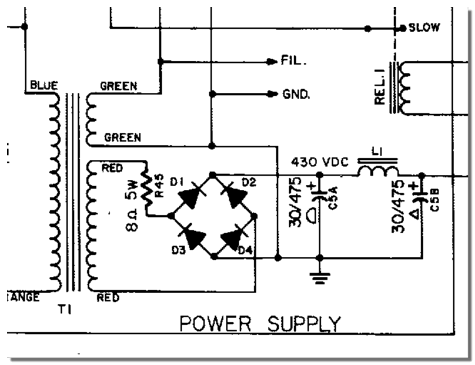
In checking the power supply remember that there are some LETHAL Voltages here!
The first voltage comes off the rectifier which may be a tube circuit on very old models or more likely a bridge rectifier made out of four diodes. This voltage should be around 430VDC.
The second voltage is found after the choke transformer. It should be around 420VDC.
The third voltage is after the OC3 regulator and should be 310VDC.
The fourth voltage is after a 10K 1watt resistor and supplies the preamp 12AU7a through the plate load resistors. It should be around 260VDC.
These voltages are general and depend highly on the line voltage and the circuit load. I routinely find them to be a little higher in the field.
If these voltages are low;
- The line voltage should be checked for 117VAC.
- The filter capacitor is weak.
- The load is over conducting. (Bad 6550 tube usually)
If these voltages are high;
- The line voltage may be high.
- The load is NOT conducting properly. (Bad 6550)
Checking the Regulator
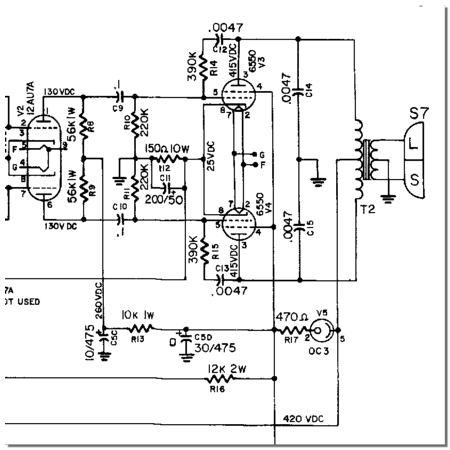
The OC3 tube is the regulator and is very important to the proper operation of the amp. Also, it practically never fails. It’s purpose is to provide a constant voltage drop or difference for the output tubes. This voltage drop should be around 105VDC.
The main job here is to provide the proper “screen” voltage to the 6550 tubes. You will notice from the schematic that the “plate” or pin 3 on the 6550 is 415VDC. The screen or pin 4 should be 105VDC lower. This voltage drop can vary somewhat and as long as it is close, you are OK. The 470 ohm resistor on pin 2 of the OC3 regulator acts as a current limiter and is a common failure part. Remember, if the 470 ohm resistor is bad, replace it with the same wattage (1/2 watt) because it also acts as a fuse. The regulated voltage should be around 310VDC and also supplies the relay and the return voltage for Leslie Switching.
Preamp Tube Voltages
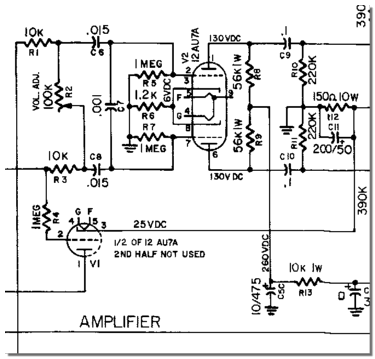
The 12AU7a tube requires a voltage to the plates. This is a dual tube and works as a balanced amplifier. The plate voltages should be checked on pin 1 and 6.
Both pins should be around 130VDC.
Usually the plate load resistors give very little trouble. Different tubes will affect the voltages depending on their conduction. Also, there may be some differences from one plate to the next due to the conduction of the tubes. If you have several tubes laying around, you might want to try to “match” the sections by measuring the plates and trying different tubes until the plates measure close to equal. I would say a 5 to 10 VDC difference isn’t a problem.
Last minute Tips
- Replace output tubes as a pair.
- Always check the 6550’s cathode resistor and bypass capacitor.
- Always suspect the 470 ohm current limiter on pin 2 of the OC3.
- The four section Filter Capacitor is crucial and should be checked.
- Clean the tube pins and check the sockets.
- Clean the volume potentiometer.
Distortion
Here’s some things to check;
- The second section of the filter/power supply is 420VDC. If this capacitor section is weak, even though the voltage might read right, the stability of that voltage may be such that it cannot deliver a constant source to the plates of the output tubes and thus cause distortion at a mid level volume.
A quick test is to measure the AC voltage here. It should be below .5 volts ac. Also, while monitoring this voltage, play sound through the Leslie. If the AC voltage rises dramatically (several volts), then this filter section is weak. - Often over looked, the preamp tube should be checked and the plate voltages also checked.
- The 15″ woofer should be 16 ohm.
- Again the cathode voltage on the 6550 should be 25VDC.
- Remember these amps are only 40 watts and can easily over driven.If all things check out and you still have problems you might have a transformer problem. This is hard to check in many cases and might just require replacing it and looking for any improvement. Power Supply transformers are usually OK if the power supply voltages are right. The Choke transformer can be bypassed as a TEST to see if it’s opening up or having a short internally. The Output transformer can cause distortion but is not easily checked. You can measure the windings and test for a proper center tap through resistance checks. These transformers don’t usually give any problems and are still available from Hammond Suzuki.
One more tip
Sometimes the output tubes will work right at first but as they warm up they might begin to over conduct causing distortion and finally blow a fuse. One visual test is to look at the outputs after they have been running for a while and see if you detect any “glowing red” color on the dark metal (plates) in the middle of the glass.
With a sensitive meter, you can monitor the input grid of the 6650’s which is pin 5. This pin should be under 1VDC. If you see this voltage climbing quickly and/or passing 1VDC, then that tube may be bad.
One other cause for a rise in the grid voltage is a bad feedback capacitor.
The .0047 @ 1600Vdc located between pin 3 and 5 via a 390K resistor can start to leak DC voltage. A quick test is to measure the voltage on both sides of the 390K resistor. If it is higher where it connects to the capacitor, then the cap is probably bad.
Any voltage applied to the grids from a leaky cap will cause the tubes to over-conduct and shorten their lives.
Leslie 122 Switching
Relay switching in a 122 is carried out by applying a DC voltage to the balanced input of the Leslie Amp. This voltage is applied equally to both input pins. Pin-1 and Pin-6. The source of this DC voltage can come from the Organ or from the Leslie itself.
Here’s how it works. The DC voltage goes into a “kit” that divides the voltage down with resistors and selectively applies it to the Leslie input through the control of the Leslie switch. The heart of the system is a 1:1 matching or isolation transformer. The divided voltage is applied to the center tap of the transformer thus applying it to both input pins equally. Since the input stage of the Leslie is capacitor coupled it effectively blocks the DC and only passes the AC (signal) to the 12AU7a tube. There is a 1meg resistor connected to pin-1 of the Leslie input that goes to the relay switching tube. It senses the DC and turns on or off the switching tube which in turn turns on or off the relay.
This voltage should be around 50 or 60 Vdc. This can vary due to the source of the voltage and is not critical. Some older kits can actually deliver up to 100Vdc. However, there is a common failure in the above circuit here that can cause the voltage to be too high. The 47K 1w resistor in the kit may open up after many years and cause the divider to not reduce the source voltage enough. This higher switching voltage can actually cause a momentary dip in volume at the time of switching. This is because the coupling caps in the Leslie input are briefly coupling the large voltage swing into the 12AU7a tube and changing it’s bias. You can put the Leslie switch in the chorale position and measure the output DC voltage with a meter. Since it only requires around 35Vdc to actually switch the relay, then for the least adverse effect on the audio, the lower this voltage, the better.
The second possible problem is the 10 mfd 450v cap inside the kit which can short. This will cause no DC to exit the kit and make the Leslie only operate on fast speed.
If this capacitor were to open up and effectively not be in the circuit, the volume dip at switching would be more obvious because the switching voltage would rise too fast.
Good Luck!

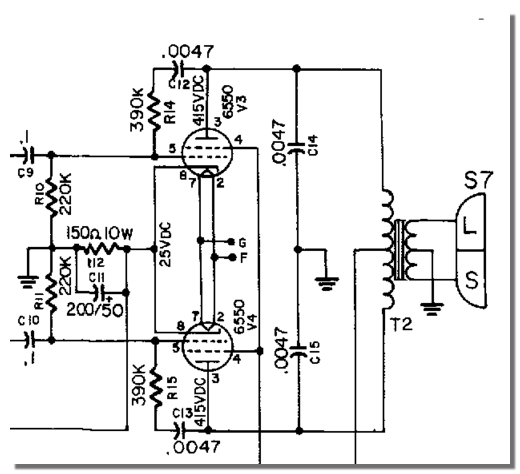




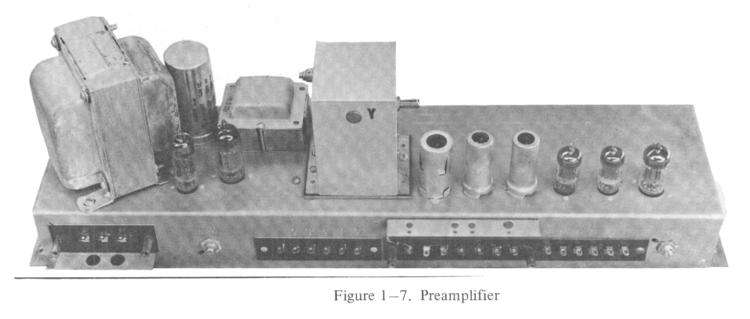
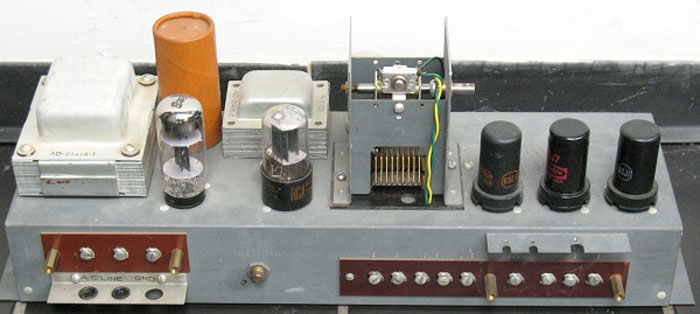

9 thoughts on “Servicing the Leslie 122 Amplifier”
I have serviced these for many years but your breakdown of all checks confirms the things I mostly know… Great JOB >>>:”))
Cliff
Looking very informational post thanks for share……………………….
The transformer is not a “matching” transformer, it is a 1 : 1.1 isolation transformer. Well, you might still insist of calling it “matching”, but the stress lies on “isolation”.
What I am missing – please correct me if I overread it – is an assignment of the bias voltage to the Leslie motor speed. Namely it is:
Bias 0V – Leslie in Tremolo mode
Bias >25V – Leslie in Chorale mode
Many SSRs (solid state relais) use 11V-20V as the range for Leslie Stop function.
—
Christoph
I thought I would add my experience fixing a 122 relay circuit. Short version: the 12K series resistor in the coil circuit was 15.3K. Replacing it fixed the problem.
Long version:
The symptom: Fast/Slow switching worked for about 10 minutes after power on, then sometimes remained on Fast when Slow is selected. Switching to Fast again and back to Slow would sometimes cause it to go Slow.
When I learned that the relay is controlled by a tube, I figured tubes age and go bad, so that must be it. I bought a new 12AU7 and dropped it in. No change.
Then I learned that the “kit” circuit in the console has a capacitor in it that, if leaky, would prevent the control voltage from rising high enough to trigger the 12AU7. I bought a capacitor, sure that this was the problem. Before I changed it I checked to voltage on it (during failure, i.e. set to Slow but running Fast) — 100 Volts, easily enough to drive the tube into saturation and trigger the relay. Not the capacitor!
I noted that the original relay had been replaced at some point with the Hammond/Suzuki relay-on-a-circuit-board. This would be easy to replace since it has a connector, but the relay goes for $45, so I needed to rule out everything else.
I checked the resistance of the 12K 10% 2 Watt resistor in series with the coil and 12AU7: it measured 15.3K, well above the tolerance of 12K + 10% = 13.2K. Furthermore, it looked like it had been very hot: not black, just cooked a bit. Nearly a smoking gun. So to speak.
I changed it out for an 11K 5% 5 Watt resistor (which is within the tolerance range of the original 10% 12K). I figured if the 2 W resistor went bad from running too hot, I’d bump that up to 5 W.
Problem solved.
Just turned on my Hammond B2 and Leslie 122 after a few years in storage. Leslie turns on running fast, relay clicks, motors slow down for about 3 or 4 seconds, then switch to fast again as if I flipped the Chorale/Tremolo switch. This occurs regardless of the position of the switch. I’ve checked the switch itself and it works, it is not shorted. I’m handy but not an electrical wiz. Looking for advice. Thanks so much.
Followup to my own question. Because the Leslie is stuck running fast, I tried plugging the slow motors into the fast motor sockets and now at least I have the slow motors running, which is more desirable for the time being. Is there any problem with doing this?
Thanks.
Oops, my bad. I used the 5pin to 6pin cable instead of the 6pin to 6pin cable. It works fine. Never mind:).
not getting audio motors turn speaker cable checked
Hi. My Leslie 122-amp is unstable and now the fuse is “going” after less than a minute.
I start up my B3 the normal way and after som minutes the fuse break and its total silence. A company in Norway has serviced it for me and it worked fine for a while. Suddently it started to break the fuse. Does anyone have a good advice for me?
Can it be the organ or do You think it is an amp-issue?
Trond
Comments are closed.